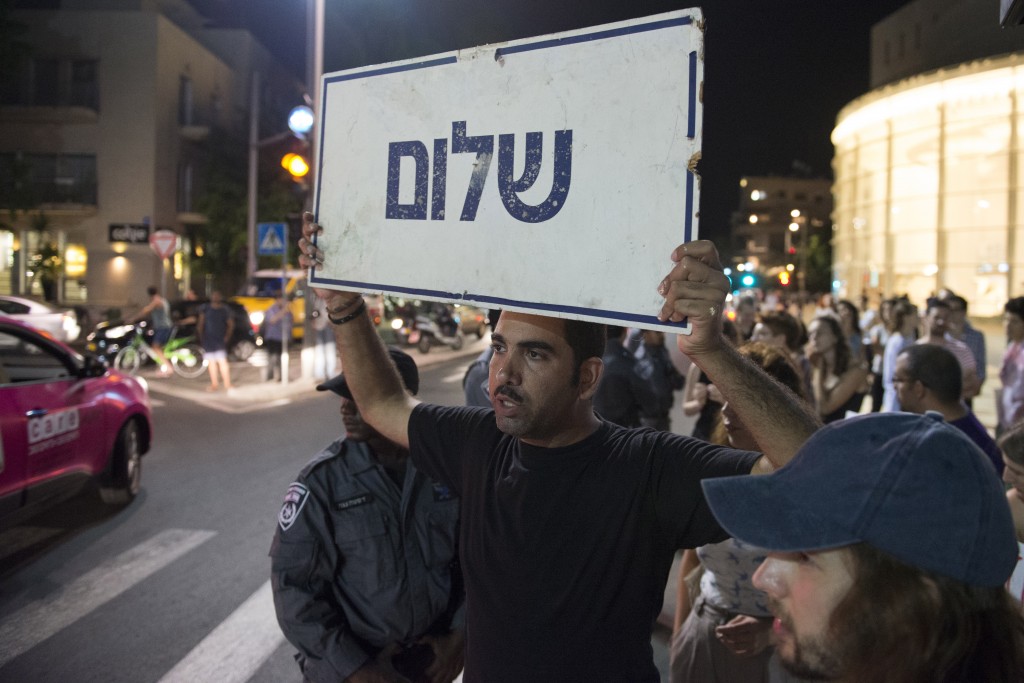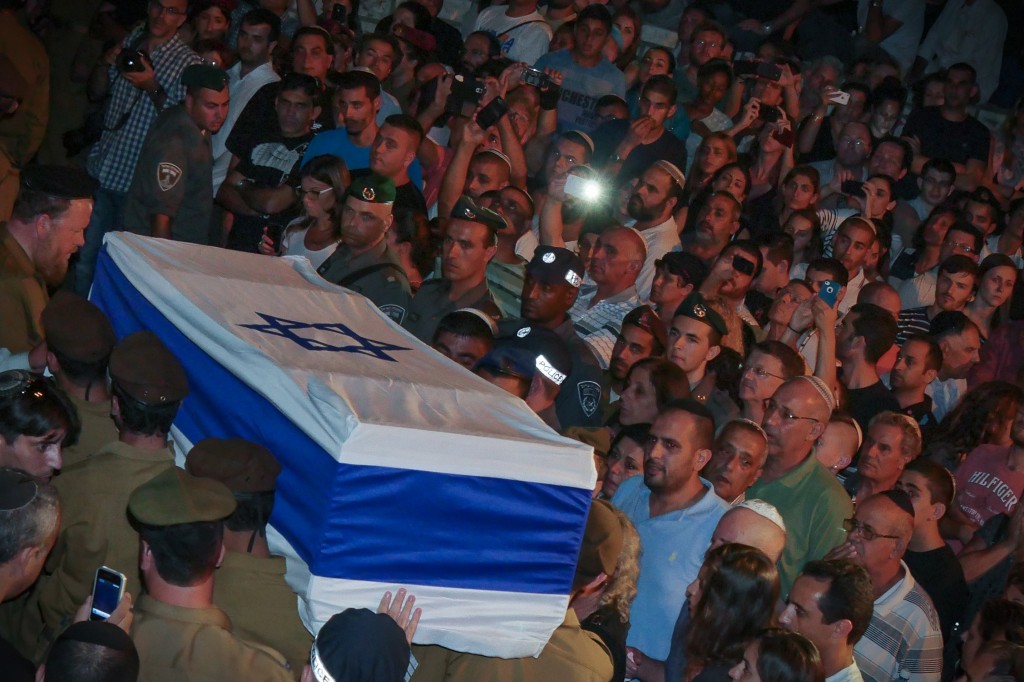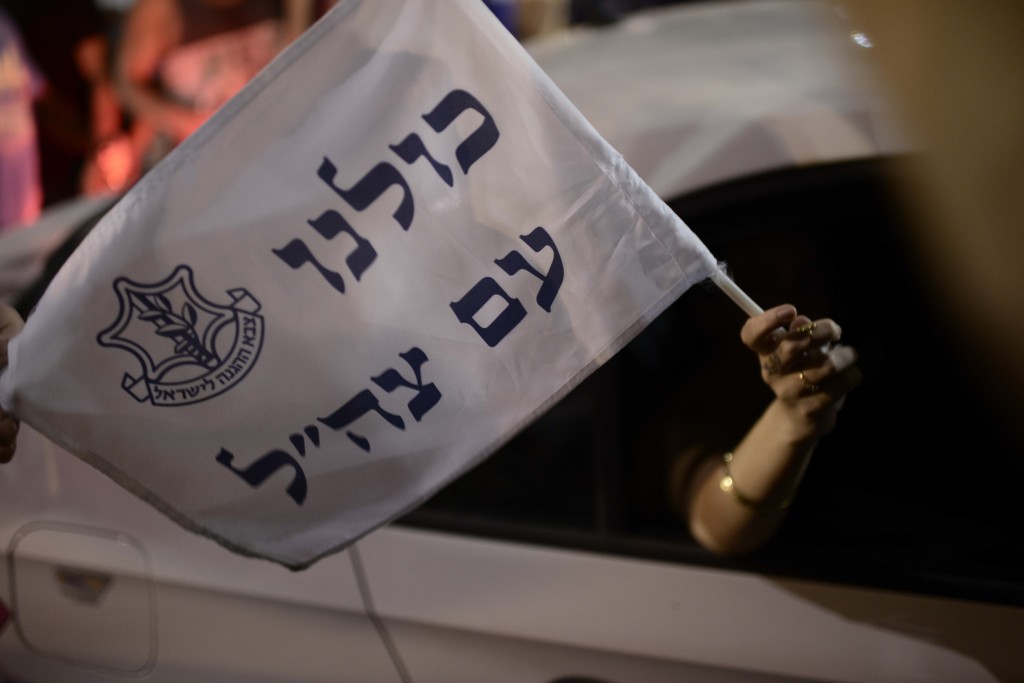How does a country with so many conflicting moral worldviews come together at times of war?
Israel is boiling. The Gaza Strip may be literally engulfed in flames, but Israel is boiling emotionally. Once again, a conflict with Hamas has left Israelis searching feverishly for an answer to a decades-old question: How do we bring this to an end?
Israeli politics and society used to give two main answers to this question. The Left promoted dialogue and compassion. The Right stood for a more security-focused and uncompromising approach. Both sides held to their opposing positions throughout numerous military operations against Hamas. We are all too familiar with both conflict in Gaza and the sociopolitical dialogue that accompanies it.
Usually, as rockets fell on the towns surrounding the Gaza Strip and the Israeli Air Force bombarded Hamas strongholds, Israeli society lined up on opposing sides: “We must destroy Hamas,” the Right exclaimed. “No, we need to find a path to peace through negotiations,” the Left answered. Over the eight-and-a-half years since Hamas came to power, this has repeated itself almost word to word every time.
This feeling of stagnation has taken its toll on Israelis. We feel trapped. Trapped in a never-ending cycle of escalation and ceasefire. Trapped by our own inability to reach a consensus and act on it. We are, for lack of a better word, exhausted—on both the Right and the Left. And this exhaustion is now finding two contradictory outlets: On the one hand, increasing division. On the other, a remarkable coming together.
Israel’s first military operation in the newly independent Gaza Strip—Operation First Rain—came on September 23rd, 2005; just 11 days after Israel completed its unilateral withdrawal. It lasted only one week, and there were no boots on the ground. Since then, there have been seven more such operations in Gaza, including the current one.
Operation First Rain was undertaken in retaliation for rocket attacks on the city of Sderot. Since then, Sderot has transformed into a national symbol of an impossible reality. It is a small city of just over 21,000 residents, located just one mile from Gaza. Over the last decade, it has become what is probably the most bombarded city in the world, absorbing constant rocket attacks at a devastating rate. It is half a city and half a bomb shelter.
Every time the attacks on Sderot escalated beyond the acceptable—and it is almost impossible to fathom such a thing as an “acceptable” rate of rocket attacks—the IDF retaliated. Sometimes with air strikes, sometimes with ground troops. Each operation resulted in loss and suffering on both sides of the fence. Each operation saw Israeli society, politicians, and media repeating the same arguments, the same talking points, and the same coverage.
On his show Last Week Tonight on July 20th, HBO’s John Oliver illustrated this point by presenting clips of CNN’s Anderson Cooper reporting on the conflict in 2006, 2009, 2012, and 2014. The reports were practically identical. But what for some American audiences is a comic observation is a painful reality for the people of Israel. It is impossible to understand the current Israeli state of mind without understanding this first.
So has anything changed during this current round of fighting?
Yes. First, the duration and scope of Hamas’ rocket attacks. For the first time, almost the entire country is within range. Warning sirens are heard repeatedly not only in the southern cities of Ashdod, Ashkelon, and Beersheva, but also Tel Aviv and Jerusalem. Israelis’ sense of security has sunk to a new low, despite the success of the Iron Dome missile defense system. It is true that there have been very few civilian casualties and minimal damage to property. Nonetheless, the daily routine of sirens, running for shelter, waiting to hear the explosion, and then texting our loved ones to make sure they are safe, is extremely draining.
Second, there are the events currently unfolding in Gaza. Once the ground operation began, it was obvious that soldiers would die. On the first day, after a report of a single casualty who was tragically killed by friendly fire, Israelis took a deep breath. A day later came the second report: 13 soldiers from the elite Golani Brigade had been killed in a single night.
The news sent shock waves around the country. It is hard to explain this feeling. It was the number of dead, it was the fact that they were all Golani, and it was the realization that we were heading into a particularly vicious and bloody round of fighting. The knowledge that each coming day would open with more reports of fallen soldiers sparked a heated internal debate about the cost in human life versus the uncertain effectiveness of yet another military operation in Gaza. The Right exploded in anger and openly called for the destruction of Hamas, the reoccupation of Gaza, and forceful military retaliation. The Left denounced the cycle of violence and called once again for negotiations instead of fighting.

Left-wing activists rally at Habima Square, Tel Aviv, against the recent escalation of violence and racial hatred, July 3, 2014. The man’s placard says “Shalom” – “Peace.” Photo: Danielle Shitrit / Flash90
This coin had another side: The devastating destruction and numerous casualties among the Gazans themselves. We might disagree on how to remove the threat of rockets and tunnels, but we all feel sorrow and even guilt for the Palestinian people. We are all sensitive to the unfortunate fate of Palestinian civilians who pay the price for Hamas’ actions. It would be hard to find Israelis who are comfortable with the hundreds of dead, thousands of wounded, and tens of thousands of people forced to flee their homes. The images coming in from Gaza do not leave us unfazed. This is a crucial point to understand. The burden of taking innocent life is scorching us as a society.
The polarizing debate over all of this was held not only among politicians and media commentators, but spread quickly to the Internet and the streets. Online social networks are fertile ground for animosity and harsh language that fuel action in the real world. Demonstrations were held daily all over the country and saw violent clashes between Right- and Left-wing demonstrators, with each side expressing their opinions in more and more extreme terms.
For a brief moment, after physical violence erupted during demonstrations in Tel Aviv on July 12th and Haifa on the 18th, it seemed that the delicate social fabric of Israel, which has been stretched thin for over a decade, was about to break. The media unleashed its hysterical rhetoric about brother picking up arms against brother, of Right and Left reaching a boiling point from which there would be no return.
As is usually the case with the media, their speculation proved to be exaggerated. These were extreme incidents, a few dozen overheated individuals who lost control. But they did illuminate the growing frustration among Israelis with the continuous cycle of escalation and ceasefire. Israel’s decade-long inability to resolve the conflict with Gaza led its citizens to channel their anger and frustration toward each other.
But this very difficult time for Israelis, filled with reports of soldiers killed in Gaza and heated, polarizing demonstrations all over the country, had a silver lining. It came in the form of unanimous, heartfelt support for our troops. As a country with mandatory military service, we have all been soldiers. We all served; our children will serve; and everyone we know either served, serves, or will serve. This is the one thing that unites all Israelis. It is the melting pot of Israel.
Once wounded soldiers started arriving at hospitals, civilians poured into the hospitals as well. Some simply came to show support, to cheer up the wounded and their families. Many came with hot food, snacks, and clean clothes. In supermarkets everywhere one can see volunteers standing at the exits with signs asking for donations—both for wounded soldiers and those still fighting in Gaza. Shoppers take items from their bags and hand them over to volunteers who transport them to hospitals and military outposts. So many snacks and candies have flooded into hospitals that one administrator half-jokingly asked the public to stop bringing candy to soldiers for fear they will leave the hospital with diabetes.
When it came to the troops, everyone left their political agenda at home. There is no conflict and no anger when Israelis tend their wounded and mourn the dead; just a hopeful and inspiring coming together. This became particularly clear when 21-year-old Sergeant Sean Carmeli was killed in Gaza on July 20th. Carmeli was a Lone Soldier from a small town in Texas. Lone Soldiers are foreign nationals who move to Israel without their families in order to serve in the army. Carmeli was also a devoted fan of the Israeli soccer team Maccabi Haifa. When word of his death reached the team’s fan club, its members knew that because he was a Lone Soldier, there was a possibility that his funeral would only be attended by his family, who had flown in from Texas. So they posted a call to other fans on their Facebook page, asking them to attend the funeral and pay their last respects to Sean. The post went viral in a matter of hours.

20,000 Israelis attend the funeral of IDF soldier Nissim Sean Carmeli, from Texas, at the military cemetery in the northern Israeli city of Haifa, Monday, July 21, 2014. Carmeli was killed on July 20th during clashes with Hamas militants during the Israeli ground operation in the Gaza Strip. Photo: Flash90
The funeral, held on the same day, was attended by 20,000 people from all over the country, practically all of them complete strangers to Sean. The funeral was broadcast on all TV channels, and the images of masses of people following Sergeant Carmeli’s funeral procession in silence resonated deeply with the Israeli public. On July 30th, another funeral was held for a Lone Soldier, Sergeant Max Steinberg from Los Angeles. This time, 30,000 people attended. This extraordinary coming together, regardless of political views, was a humbling lesson for us all.
In a way, this extraordinary outpouring of national solidarity began before the war itself. As has been reported all over the world, the current round of fighting was the direct result of the kidnapping and murder of three Israeli teenagers by Hamas terrorists. During the 18 days that passed until their bodies were found, Israelis held their collective breath and hoped for a happy ending to the story, slim as the chances might be. Support for the families poured in, and the wall-to-wall feeling of loss and grief that gripped Israeli society demonstrated that our divisions can only go so far. The brief outburst of heightened emotions at demonstrations in Tel Aviv and Haifa was overwhelmed by a strong sense of togetherness among the Israeli public. We quarrel, we disagree, but it is meaningless on the larger scale of things.
This particular round of fighting is different for another reason as well: The discovery of Hamas’ horrifying network of tunnels. As the full scope of the tunnel network emerged through TV footage from Gaza, the Israeli public was stunned. The tunnels’ existence was well known in Israel. But in all honesty, what we imagined was very far from what was revealed.
We had imagined a few small and dark passageways, dug by hand, Shawshank Redemption-style. But when reports came in of more than 30 tunnels running from Gaza into Israeli kibbutzim and moshavim, and footage showed them to be professionally constructed, lined with cement, and connected to electricity, our naiveté evaporated. The last straw was the revelation that Hamas had planned a mass terror attack using the tunnels, set to take place on the Jewish high holidays—an attack that could well have claimed thousands of lives.
To us, it does not matter what the intelligence community knew or didn’t know about the tunnels. They probably had a much more realistic understanding of the breadth of the tunnel infrastructure than the public. But once this massive undertaking by Hamas came to light—years of labor and millions of dollars in investment—Israelis were lost for words (and Israelis are very rarely lost for words). We needed a collective minute to gather our thoughts and process the information.
This collective pause left many Israelis severely conflicted. The potential danger presented by the tunnels was horrifying. In conversations all over Israel, people spoke in hushed voices about what could have happened if the tunnels had not been discovered and destroyed. Those were sad conversations. Sad because of the people, the real people who live their lives at the end of those tunnels, who could have lost their lives in the most senseless way imaginable.

A woman holds a flag reading “All of us are with the IDF: as she drives by a demonstration in Rabin Square in Tel Aviv, July 26, 2014. Photo: Tomer Neuberg / Flash90
This was followed by a sense of complete bewilderment directed at Hamas. Why had all this money and effort gone into digging tunnels intended for terror attacks and not into providing for their people’s basic needs? We are painfully aware of conditions in Gaza, and it gives us no comfort. The fact that Hamas chose to direct all its resources to planning and executing this mind-blowing attempt at attacking Israeli civilians instead of assisting their own civilians was impossible to comprehend.
And then bewilderment turned into anger. Anger in its most simple form. Anger born of frustration. Looking at the full picture of Hamas’ “tunnels operation” in Gaza is enraging. This needs no explanation.
But with this anger came a crippling, conflicted feeling that the answer to our decades-old question is now much harder to find. The vast majority of Israelis, Right and Left, see the two-state solution as the only possible solution to the Israeli-Palestinian conflict. There are, and always will be, extremists on both ends of the political spectrum; but the center-Right and center-Left, each for their own reasons, know—or knew—that a State of Palestine is only a matter of time. I would even dare to say that this majority feels that it is not only the logical solution, but also the right one.
Now this feeling is obscured by the heavy shadow of the tunnels. On the one hand, we want the Palestinians to have their state, to enable them to live in comfort and prosperity. It is long overdue, and we know it. On the other hand—the tunnels. Tunnels that Israelis see as a tremendous obstacle to resolving the conflict. Not the 30 tunnels themselves that have been discovered and are being destroyed by the IDF—it is the idea of the tunnels and what they represent: That Hamas will stop at nothing, that decades of living under occupation has left a serious mark on the Palestinians as a people, that their anger with us will take many years to subside.
So what do we do now? How are Israelis to reconcile these conflicting emotions? It is logical to assume that a “solution” to the tunnels will be found, in the same way as Iron Dome is a “solution” to rocket attacks. We will spend millions of dollars in order to counteract the millions of dollars spent on the other side.
But that is not a real solution. Because the problem is not the rockets or the tunnels, but the feelings of the people who build them. And the same is true of our feelings. We don’t build missile defense systems with glee and searching for a solution to the tunnels doesn’t bring us joy. We and the Palestinians are now two peoples trapped in an agonizing, destructive relationship.
At the time of this writing—the last week of July—the fighting is still raging in Gaza. As the death toll on the Palestinian side rises and Israeli soldiers are being killed daily, backroom negotiations on a ceasefire are being reported.
This is all painfully familiar to both sides. U.S. Secretary of State John Kerry and U.N. Secretary-General Ban Ki-Moon came and went. Khaled Mashaal gave a speech. Protests denouncing Israel were held all over the world. The Israeli Left and Right continue to quarrel, and at the same time bring too much candy to wounded soldiers. This is our life in a nutshell.
This time around, however, it seems as if the vast majority of Israelis—from both sides of the political spectrum—have adopted a more forceful attitude toward the fighting in Gaza. Polls conducted in recent days show overwhelming support for continuing the military operation. This can only be viewed as an alarming development in the public’s state of mind. Even taking into account the inevitable deaths of Israeli soldiers and Palestinian civilians, Israelis are saying out loud that we must forge ahead. This is a departure from public opinion in previous operations, which, for the most part, rooted for a ceasefire. If nothing else, this tells us that Israelis are fed up with the never-ending cycle of conflict in Gaza. They are demanding a solution for both peoples, and this time a real one.
![]()
Banner Photo: Tomer Neuberg / Flash90





